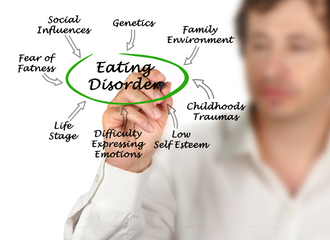Written by: Rebecca Berman, LCSW-C, MLSP, CEDS-S
Clinical Training Specialist, The Renfrew Centers
Treating co-occurring conditions, like trauma and eating disorders, is a complex process. In this post, we look at the different approaches and solutions.

What we have found in the past, prior to implementing Renfrew’s evidence-based treatment model, is that when you treat one diagnosis–the other pops up, and usually stronger. To avoid feeling uncomfortable, individuals engage in emotion-driven behaviors (EDBs). This is not exclusive to the eating disorder; we see it in depression, anxiety, and even trauma, just to mention a few.
Patients may avoid going to certain places for fear of a particular emotional response, entering intimate relationships, eating certain foods or wearing certain clothing – and then engage in symptomatic behaviors to stop, dampen or avoid the emotional intensity.
Trauma & Emotional Disorders
Those with emotional disorders, including eating disorders and PTSD, feel emotions more intensely, more frequently and often out of context. We refer to experiential avoidance, as avoiding people, places, things, emotions, etc. that make us feel uncomfortable. The more we avoid, the bigger the problem becomes.
By not treating the trauma at the same time as the eating disorder, it continues to be avoided. Additionally, as someone is working on their trauma, they have stronger urges and often need more support. There are a lot of different pieces to be mindful of dissociative memories of abuse and delayed PTSD may emerge spontaneously once nutritional rehabilitation occurs.
How to Treat Trauma & Eating Disorders Together
It’s essential to first consider the individual’s immediate safety in terms of suicidality and medical status. Ideally, the solution is to treat both the eating disorder and trauma, and any additional disorders, at the same time.
Experiential avoidance is common in almost all emotional disorders—not only is it common, but it is what reinforces and maintains the disorder. The key here is that it is not so much what the individual is avoiding (i.e., certain foods, public places, etc.), it is the belief that they cannot handle the situation, and if put in the situation that they wouldn’t be able to cope.
Spoiler alert – usually the feared outcome doesn’t happen and if it does, we are able to cope.
Why? Because we can do hard things. And because in treatment, rather than addressing the individual disorders, we look at the underlying principles and create treatment interventions that are designed to build emotional mastery and increase cognitive flexibility.
Populations we work with require specialized treatment in recognizing, understanding and responding to their emotions.
Managing the Core Beliefs
Another part of experiential avoidance and treating both the eating disorder and trauma concurrently is looking at the role of core beliefs. For several different reasons, individuals develop core beliefs about themselves.
These may sound like, “I’m unworthy, I’m unlovable, it’s my fault, I’ll end up alone, I’ll never get better.” For those with a history of trauma, they learn that these beliefs may have come out of their traumatic experience(s) or reinforced by the experience(s). These beliefs fuel the eating disorder and are hard to change.
By utilizing The Renfrew Unified Treatment Model for Eating Disorders®, patients learn to identify these thoughts, label and tolerate the emotion(s) that come with these appraisals and have led to destructive behaviors in the past, explore what current and previous events may have led to these beliefs, and begin to build cognitive flexibility by creating re-appraisals. For example, if a patient has the belief that, “I can’t get better” or “I’m unworthy,” then they tend to avoid situations that may challenge these thoughts.
Renfrew’s Trauma Track allows patients to explore how their trauma(s) has impacted the relationship with themselves, with others and with the world. Patients identify themes that include safety, trust, power and control, esteem, and intimacy. By focusing on these different dynamics, patients challenge the pattern of avoidance.
Conclusion
To be successful in this work, it is critical for patients to learn how to approach all different emotions, especially the hard ones, rather than avoid them.
If they wait to address the trauma until the eating disorder is healed, then they miss out on powerful therapeutic opportunities and continue with the avoidance patterns that have fueled the eating disorder.
If we try to treat the trauma separately, then the individual will most likely use the eating disorder or other problematic symptoms to manage the thoughts, memories and beliefs that surface – therefore cycling between symptoms and going in and out of treatment.
By treating the eating disorder and trauma together, we can see more clearly how they impact each other, save time by utilizing the same skills and concepts to treat both, and build emotional tolerance and psychological flexibility — versus switching back and forth between less effective short-term coping strategies. By building emotional tolerance and psychological flexibility we can achieve the ultimate goal of treatment, creating sustainable change.


